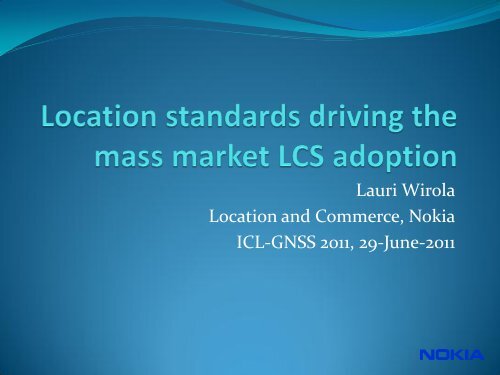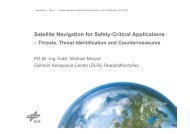Lauri Wirola, Nokia, Finland - ICL-GNSS
Lauri Wirola, Nokia, Finland - ICL-GNSS
Lauri Wirola, Nokia, Finland - ICL-GNSS
- No tags were found...
Create successful ePaper yourself
Turn your PDF publications into a flip-book with our unique Google optimized e-Paper software.
<strong>Lauri</strong> <strong>Wirola</strong>Location and Commerce, <strong>Nokia</strong><strong>ICL</strong>-<strong>GNSS</strong> 2011, 29-June-2011
Outline• case for standardized location technologies• location standards categories• brief history• current state and deployment status• location standards state-of-the-art
Technology challengewith(out) anyconnectivitymust work everywhereenvironment is not anexcusefast – time-to-first-fix
Why standards• bolts and nuts – interoperability is essential• make money through licensing
Space of standardized positioningtechnologies in use todayAvailability67%
control plane vs. user plane• two ways of carrying positioning signaling to the device• control plane – integral part of the cellular network• low bandwidth• high integrity and security• use case cases limited to e-call, law & enforcement andnetwork planning/monitoring• user plane – works on top of the data connectivity providedby the physical network• high bandwidth• potential issues with integrity• de-facto method of providing position information tolocation-based value-added services
architecture – big pictureProtocols:Control Plane: RRLP/RRC/LPPUser Plane: SUPL<strong>GNSS</strong> satelliteGSM,UMTS,LTELocation Server(SMLC)(BSS, RNC, MME)- Network maintenance(e.g. cell-id database)- Network controlWARNAssistance dataservices(GMLC)Location-based servicesAuthorities
3GPP Radio Resource Location Protocol Rel-5/8OMA Secure User Plane Location Rel 1.0/2.0
In the beginning• history of location standards dates back to the late 90’s• work in GSM, AMPS, TDMA and CDMA domains• UMTS followed a few years later• nowadays GSM, UMTS and LTE positioning work donein 3GPP• 3GPP2 taking care of CDMA/CDMA2000 networks
OMA Secure User Plane Location Rel 3.03GPP LTE Positition Protocol Rel-9/10OMA LTE Positioning Protocol Extensions Rel 1.0
LTE Positioning Protocol, LPP• in autumn 2009 3GPP started the latest push forlocation services• control plane positioning protocol for LTE (3.9G) andLTE-Advanced (4G) networks• LPP was designed from day one to be• true <strong>GNSS</strong>• self-contained (A<strong>GNSS</strong>, ECID, OTDOA)• to do the bare minimum to support emergency,law&enforcement and network maintetance use cases(but nothing more!)
LTE Positioning Protocol Extensions• 3GPP knew that a wide number of emergingtechnologies were out-of-scope• to support future development 3GPP decided toinclude extension containers to the LPP messages• Open Mobile Alliance started work on LPP ExtensionsRel 1.0 early 2010• standard is now in candidate status waiting forapproval
Vision for LPP Extensions• to bring all the already standardized technologies underthe same umbrella• basic A<strong>GNSS</strong>• enhanced Cell ID• hyperbolic time-based methods• to bring the potential of professional-grade <strong>GNSS</strong> to themass markets, including• Real-Time Kinematics• Precise Point Positioning• take first steps in standardizing indoor-capable positioningmethods
Fixed Baseline error (m)Assisted <strong>GNSS</strong> in LPPe Rel 1.0• continuous carrier phase assistance accuracy• multiple reference stations• reference station mobility• periodic session control• local ionosphere corrections accuracy• also on periodic basis• also geomagnetic storm warnings4 x 10-3 Citymarket car park; Test 1; 8th Jan 2007 : Fixed solutionValidation in 25 s.EastNorth2Up0-2-4-6-8-100 200 400 600 800 1000 1200 1400Time (s)
Assisted <strong>GNSS</strong> in LPPe Rel 1.0• local troposphere corrections accuracy• either delays or surface parameters• mapping functions• altitude assistance availability• SV mechanics time-to-first-fix• mass, solar panel reflectivity, solar radiation pressure• navigation model degradation integrity• differential code biases accuracy
Cellular methods• Enhanced Cell ID• GSM, UMTS, LTE• base station position, Tx power, antenna gain, azimuth,beam width, frequency drift• Time Difference of Arrival• E-OTD• OTDOA• OTDOA-IPDL
Non-cellular methods• WLAN radiomaps• locations (indoor and civic support), coverage area, Txpower• tags/beacons• support for carrying locations of sets of tags/beacons• RFID, BT Low Energy• motion state delivery
Secure User Plane Location 3.0• OMA SUPL Rel 3.0 is the preferred User Plane wrapperfor LPPe Rel 1.0• adds on top of SUPL 1.0• geographic and temporal triggers (SUPL 2.0)• streaming of assistance data (SUPL 3.0)• locally discovered assistance/positioning server (SUPL 3.0)• support for WLAN data bearer (SUPL 3.0)
Space of standardized positioningtechnologies in use tomorrowAvailability67%
Roadmap2009 2010 2011 2012 2013 2014 2015GLOBAL SYSTEM FORMOBILE COMMUNICATIONS•RRLP Rel-8 withGPS & GANSS•SUPL 1.0R•SUPL 2.0 finalizedLocation Standards Vol-1SUPL2-RRLP deploymentsVol-2.0•LPP Rel-9with <strong>GNSS</strong>Vol-2.1LPP Extensions•A<strong>GNSS</strong>harmonization•RTK, PPP•Advancedatmospheremodels•tags, beacons,access pointsVol-2.2Location Standards Vol-2SUPL 3.0 finalized•Streaming•CloudarchitectureSUPL3-LPP deploymentsLocation Sandards Vol-3 (authentication, peer-to-peer assistance,indoors, visual assistance?)Multiple <strong>GNSS</strong>s, multiple signals
Key takeaways• standardized positioning technologies (A<strong>GNSS</strong>,Enhanced Cell ID, TDOA-methods) are backbonetechnologies for location services• OMA LPP Extensions 1.0 and OMA SUPL 3.0 push theenvelope of standardized positioning technologies• predict that after the latest push there will be a quietperiod to give time for markets to evolve• in the coming years the emphasis is on standardizingthe indoor positioning methods
Key takeaways• standardized positioning technologies (A<strong>GNSS</strong>, Enhanced CellID, TDOA-methods) are backbone technologies for locationservices• OMA LPP Extensions 1.0 and OMA SUPL 3.0 push the envelopeof standardized positioning technologies• predict that after the latest push there will be a quiet period togive time for markets to evolve• in the coming years the emphasis is on standardizing the indoorpositioning methodsTHANK YOU!Q & A






